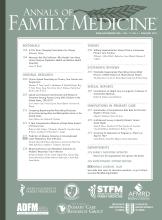Research is a word that intimidates many faculty and program directors and while the Review Committee for Family Medicine mandates the generation of scholarly output, we often shy away from research involving data collection and analysis. The lack of residency faculty-lead research contributes to the paucity of family medicine (FM) researchers and the diminishing FM research pipeline. The Council of Academic Family Medicine (CAFM) Educational Research Alliance (CERA) was designed to assist faculty in residency programs to conduct research. So, what is CERA? How does it benefit residency programs? What should we do next?
What?
CERA, a CAFM initiative, was created as a tool for FM researchers. It provides infrastructure, researcher consultation, and facilitated collaboration to conduct research via survey. It will develop a vigorous FM research database which will be available to all. One of CERAs primary initiatives is to improve the process of administering research surveys to the constituents of the CAFM organizations (STFM, NAPCRG, AFMRD, and ADFM). CERA sends calls for proposals to CAFM members for survey questions that have potential to yield peer-reviewed publications. The number of survey questions on a particular topic is generally limited to 10. A 13-member steering committee makes decisions on proposals and provides mentorship to applicants.
CERA sent its first survey to all residency programs in June 2011. Currently it surveys residency directors 2 times per year; general residency faculty annually, and clerkship directors and medical school faculty annually. This coordinated effort around surveying constituents results in higher quality questions and fewer surveys.
So What?
Have you ever considered conducting a survey you thought explored important issues in family medicine and could have enduring value for our discipline, but never pursued it because of any of the following barriers?
-
My program is too small so my sample would be too small
-
I don't know how I would get other residency programs to take part in this
-
I have never been trained in survey design and there is no one in my program or institution to help me
-
I don't know how to move from a survey question to a research project
The mission and purpose of CERA address all of the barriers above.
Now What?
As requirements around scholarly activity for faculty put greater emphasis on peer review, CERA can play an important role in faculty development for your program and help increase scholarly productivity. The mentoring and guidance built into the infrastructure of CERA can provide the resources that are simply lacking and unavailable to many programs. Programs should encourage faculty to submit questions to CERA for primary research as well as utilize the data in the CERA clearinghouse for secondary data analysis.
We cannot rely on the designated department researchers to solely carry the responsibility of creating and sustaining family medicine research efforts. Teaching scholarly inquiry and evaluation is an obligation of family medicine residency programs and we must continue to explore opportunities like CERA that can help us fulfill that obligation.
For more information regarding CERA, visit www.stfm.org/initiatives/CERA.cfm.
- © 2012 Annals of Family Medicine, Inc.







